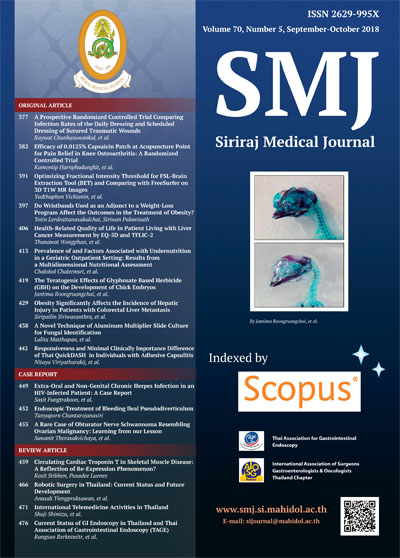International Telemedicine Activities in Thailand
Keywords:
Telemedicine; remote medical education; internet; endoscopy; surgeryAbstract
The development of information and communication technology has had a dramatic impact on people’s lives,
including medical matters. The Internet has made it possible for telemedicine to be implemented with excellent image
quality at low cost; such telemedicine was first applied between Japan and South Korea in 2002. The technology is
not restricted to advanced countries: it can also be applied in developing nations, and it has expanded rapidly to
other parts of Asia and beyond. In 2005 Thailand became the seventh country to be associated with the Telemedicine
Development Center of Asia (TEMDEC). As of 2017, TEMDEC operates 144 programs in Thailand, mainly in
endoscopy (55, 38%) and surgery (40, 28%): 17 hospitals or medical institutions are active members, and there are
165 telemedicine connections. Siriraj Hospital, Mahidol University was the first participant; it has 71 telemedicine
connections; King Chulalongkorn Memorial Hospital became the second participant; it has 52 such connections.
These two hospitals account for 74.5% (123/165) of all telemedicine activities in Thailand. Compared with outside
Bangkok, the number of telemedicine connections is 14 times (154/11) greater and the number of such connections
per hospital is 10 times (15.4/1.6) greater in the capital-even though the number of hospitals is only 1.4 times (10/7)
greater in Bangkok. To efficiently meet local needs, we strongly hope that telemedicine will expand into rural parts
of Thailand and into more medical specialties through ongoing technological development.
Downloads
Published
How to Cite
Issue
Section
License
Authors who publish with this journal agree to the following conditions:
Copyright Transfer
In submitting a manuscript, the authors acknowledge that the work will become the copyrighted property of Siriraj Medical Journal upon publication.
License
Articles are licensed under a Creative Commons Attribution-NonCommercial-NoDerivatives 4.0 International License (CC BY-NC-ND 4.0). This license allows for the sharing of the work for non-commercial purposes with proper attribution to the authors and the journal. However, it does not permit modifications or the creation of derivative works.
Sharing and Access
Authors are encouraged to share their article on their personal or institutional websites and through other non-commercial platforms. Doing so can increase readership and citations.











